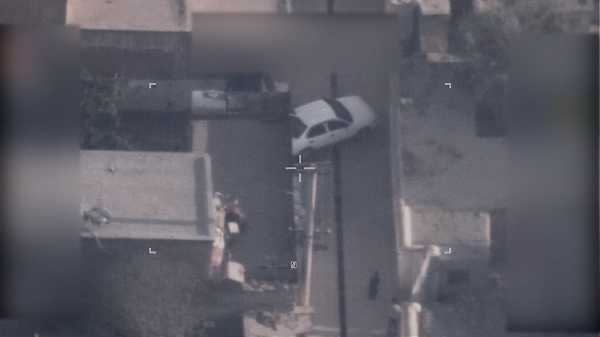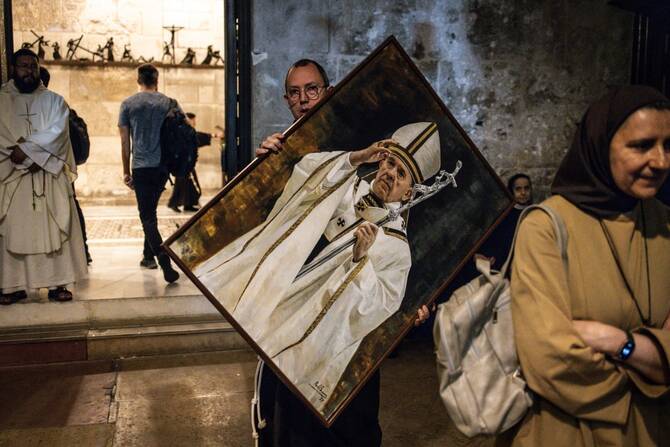Documents obtained through a lawsuit reveal how biases led to the deadly August 2021 blunder, and that officials made misleading statements concealing their assessment of civilian casualties.
-
Send any friend a story
As a subscriber, you have 10 gift articles to give each month. Anyone can read what you share.
Give this articleGive this articleGive this article

Relatives and neighbors at the site of a U.S. drone strike that killed 10 civilians in August 2021.
WASHINGTON — In the chaotic final days of the U.S. withdrawal from Afghanistan in August 2021, U.S. military analysts observed a white Toyota Corolla stop at what they believed was an Islamic State compound.
The Americans were already on edge. Three days earlier, a suicide bomber had killed scores of Afghans and 13 U.S. troops at a main gate of the Kabul airport. Now, officials had intelligence that there would be another attack there, and that it would involve a white Corolla.
They tracked the car around Kabul for the next several hours. After it pulled into a gated courtyard near the airport, they authorized a drone strike. Hours later, U.S. officials announced they had successfully thwarted an attack.
As reports of civilian deaths surfaced later that day, they issued statements saying they had “no indications” but would assess the claims and were investigating whether a secondary explosion may have killed civilians.
But portions of a U.S. Central Command investigation obtained by The New York Times show that military analysts reported within minutes of the strike that civilians may have been killed, and within three hours had assessed that at least three children were killed.
The documents also provide detailed examples of how assumptions and biases led to the deadly blunder.
Military analysts wrongly concluded, for example, that a package loaded into the car contained explosives because of its “careful handling and size,” and that the driver’s “erratic route” was evidence that he was trying to evade surveillance.
The investigation was completed a week and a half after the strike and was never released, but The New York Times has obtained 66 partially redacted pages of it through a Freedom of Information Act lawsuit against Central Command.
Central Command declined to provide additional comment beyond statements it had previously made about the strike. The Pentagon previously acknowledged that the strike was a “tragic mistake” that killed 10 civilians, and told The Times that a new action plan intended to protect civilians drew on lessons learned from the incident.
Among those killed was Zemari Ahmadi, a longtime aid worker and the driver of the car.
Responding to a description of the document released to The Times, Hina Shamsi, an American Civil Liberties Union lawyer representing families of victims, said the investigation “makes clear that military personnel saw what they wanted to see and not reality, which was an Afghan aid worker going about his daily life.”
The Attack
On Aug. 29, 2021, an American MQ-9 Reaper drone shot a Hellfire missile at a white Toyota Corolla in a neighborhood near the Kabul airport.
More on U.S. Armed Forces
- Defense Bill: Congress passed a $858 billion defense bill that would rescind the coronavirus vaccine mandate for troops and increase the defense budget $45 billion over President Biden’s request.
- A Boost for the N.R.A.: Instructors in military-sponsored J.R.O.T.C. classes have offered to promote the gun rights organization in high schools in exchange for money for their marksmanship programs.
- Abortion: The Pentagon is seeking to reassure service members worried about having access to abortions in states where the procedure is banned with travel funds and other support.
- Navy SEAL Recruitment: The high failure rate of the elite force’s selection course shunts hundreds of candidates into low-skilled jobs.
Within 20 minutes, multiple military officials and members of the strike team learned that analysts had seen possible civilian casualties in video feeds, according to their sworn statements for the investigation.
Two to three hours after the attack, analysts who had reviewed the footage frame by frame assessed that three children had been killed. An officer then shared that information with two top commanders in Afghanistan, Maj. Gen. Christopher Donahue, the ground force commander, and Rear Adm. Peter G. Vasely.
In sworn statements, six of nine witnesses described learning immediately after the strike that civilians were in the area and may have been killed.
ImageExcerpts from Central Command’s investigation into the botched August 2021 drone strike in Kabul, Afghanistan.Credit…United States Central Command
Later that day, Central Command said in a statement that officials were “assessing the possibilities of civilian casualties” but had “no indications at this time.”
An update several hours later noted that powerful subsequent explosions may have caused civilian casualties but did not mention that analysts had already assessed three children were killed.
Three days later, Gen. Mark A. Milley, the chairman of the Joint Chiefs of Staff, told reporters that the strike was “righteous” and had killed an ISIS facilitator as well as “others,” but who they were, “we don’t know. We’ll try to sort through all of that.”
Over the next several weeks, Pentagon officials continued to say that an ISIS target was killed in the strike, even as evidence mounted to the contrary.
On Sept. 10, a Times investigation based on video evidence and interviews with more than a dozen of Mr. Ahmadi’s co-workers and family members in Kabul found no evidence that explosives were present in the vehicle.
Mr. Ahmadi, who worked as an electrical engineer for a California-based aid group, had spent the day picking up his employer’s laptop, taking colleagues to and from work and loading canisters of water into his trunk to bring home to his family.
Officials insisted that their target had visited an ISIS “safe house,” but The Times found that the building was actually the home of Mr. Ahmadi’s boss, whose laptop he was picking up.
A week after the Times investigation was published, military officials acknowledged that 10 civilians had been killed and that Mr. Ahmadi posed no threat and had no connection to ISIS.
VideotranscriptBackbars0:00/11:02-0:00
transcript
How a U.S. Drone Strike Killed the Wrong Person
A week after a New York Times visual investigation, the U.S. military admitted to a tragic mistake in an Aug. 29 drone strike in Kabul that killed 10 civilians, including an aid worker and seven children.
[explosion] In one of the final acts of its 20-year war in Afghanistan, the United States fired a missile from a drone at a car in Kabul. It was parked in the courtyard of a home, and the explosion killed 10 people, including 43-year-old Zemari Ahmadi and seven children, according to his family. The Pentagon claimed that Ahmadi was a facilitator for the Islamic State, and that his car was packed with explosives, posing an imminent threat to U.S. troops guarding the evacuation at the Kabul airport. “The procedures were correctly followed, and it was a righteous strike.” What the military apparently didn’t know was that Ahmadi was a longtime aid worker, who colleagues and family members said spent the hours before he died running office errands, and ended his day by pulling up to his house. Soon after, his Toyota was hit with a 20-pound Hellfire missile. What was interpreted as the suspicious moves of a terrorist may have just been an average day in his life. And it’s possible that what the military saw Ahmadi loading into his car were water canisters he was bringing home to his family — not explosives. Using never-before seen security camera footage of Ahmadi, interviews with his family, co-workers and witnesses, we will piece together for the first time his movements in the hours before he was killed. Zemari Ahmadi was an electrical engineer by training. For 14 years, he had worked for the Kabul office of Nutrition and Education International. “NEI established a total of 11 soybean processing plants in Afghanistan.” It’s a California based NGO that fights malnutrition. On most days, he drove one of the company’s white Toyota corollas, taking his colleagues to and from work and distributing the NGO’s food to Afghans displaced by the war. Only three days before Ahmadi was killed, 13 U.S. troops and more than 170 Afghan civilians died in an Islamic State suicide attack at the airport. The military had given lower-level commanders the authority to order airstrikes earlier in the evacuation, and they were bracing for what they feared was another imminent attack. To reconstruct Ahmadi’s movements on Aug. 29, in the hours before he was killed, The Times pieced together the security camera footage from his office, with interviews with more than a dozen of Ahmadi’s colleagues and family members. Ahmadi appears to have left his home around 9 a.m. He then picked up a colleague and his boss’s laptop near his house. It’s around this time that the U.S. military claimed it observed a white sedan leaving an alleged Islamic State safehouse, around five kilometers northwest of the airport. That’s why the U.S. military said they tracked Ahmadi’s Corolla that day. They also said they intercepted communications from the safehouse, instructing the car to make several stops. But every colleague who rode with Ahmadi that day said what the military interpreted as a series of suspicious moves was just a typical day in his life. After Ahmadi picked up another colleague, the three stopped to get breakfast, and at 9:35 a.m., they arrived at the N.G.O.’s office. Later that morning, Ahmadi drove some of his co-workers to a Taliban-occupied police station to get permission for future food distribution at a new displacement camp. At around 2 p.m., Ahmadi and his colleagues returned to the office. The security camera footage we obtained from the office is crucial to understanding what happens next. The camera’s timestamp is off, but we went to the office and verified the time. We also matched an exact scene from the footage with a timestamp satellite image to confirm it was accurate. A 2:35 p.m., Ahmadi pulls out a hose, and then he and a co-worker fill empty containers with water. Earlier that morning, we saw Ahmadi bring these same empty plastic containers to the office. There was a water shortage in his neighborhood, his family said, so he regularly brought water home from the office. At around 3:38 p.m., a colleague moves Ahmadi’s car further into the driveway. A senior U.S. official told us that at roughly the same time, the military saw Ahmadi’s car pull into an unknown compound 8 to 12 kilometers southwest of the airport. That overlaps with the location of the NGO’s office, which we believe is what the military called an unknown compound. With the workday ending, an employee switched off the office generator and the feed from the camera ends. We don’t have footage of the moments that followed. But it’s at this time, the military said that its drone feed showed four men gingerly loading wrapped packages into the car. Officials said they couldn’t tell what was inside them. This footage from earlier in the day shows what the men said they were carrying — their laptops one in a plastic shopping bag. And the only things in the trunk, Ahmadi’s co-workers said, were the water containers. Ahmadi dropped each one of them off, then drove to his home in a dense neighborhood near the airport. He backed into the home’s small courtyard. Children surrounded the car, according to his brother. A U.S. official said the military feared the car would leave again, and go into an even more crowded street or to the airport itself. The drone operators, who hadn’t been watching Ahmadi’s home at all that day, quickly scanned the courtyard and said they saw only one adult male talking to the driver and no children. They decided this was the moment to strike. A U.S. official told us that the strike on Ahmadi’s car was conducted by an MQ-9 Reaper drone that fired a single Hellfire missile with a 20-pound warhead. We found remnants of the missile, which experts said matched a Hellfire at the scene of the attack. In the days after the attack, the Pentagon repeatedly claimed that the missile strike set off other explosions, and that these likely killed the civilians in the courtyard. “Significant secondary explosions from the targeted vehicle indicated the presence of a substantial amount of explosive material.” “Because there were secondary explosions, there’s a reasonable conclusion to be made that there was explosives in that vehicle.” But a senior military official later told us that it was only possible to probable that explosives in the car caused another blast. We gathered photos and videos of the scene taken by journalists and visited the courtyard multiple times. We shared the evidence with three weapons experts who said the damage was consistent with the impact of a Hellfire missile. They pointed to the small crater beneath Ahmadi’s car and the damage from the metal fragments of the warhead. This plastic melted as a result of a car fire triggered by the missile strike. All three experts also pointed out what was missing: any evidence of the large secondary explosions described by the Pentagon. No collapsed or blown-out walls, including next to the trunk with the alleged explosives. No sign that a second car parked in the courtyard was overturned by a large blast. No destroyed vegetation. All of this matches what eyewitnesses told us, that a single missile exploded and triggered a large fire. There is one final detail visible in the wreckage: containers identical to the ones that Ahmadi and his colleague filled with water and loaded into his trunk before heading home. Even though the military said the drone team watched the car for eight hours that day, a senior official also said they weren’t aware of any water containers. The Pentagon has not provided The Times with evidence of explosives in Ahmadi’s vehicle or shared what they say is the intelligence that linked him to the Islamic State. But the morning after the U.S. killed Ahmadi, the Islamic State did launch rockets at the airport from a residential area Ahmadi had driven through the previous day. And the vehicle they used … … was a white Toyota. The U.S. military has so far acknowledged only three civilian deaths from its strike, and says there is an investigation underway. They have also admitted to knowing nothing about Ahmadi before killing him, leading them to interpret the work of an engineer at a U.S. NGO as that of an Islamic State terrorist. Four days before Ahmadi was killed, his employer had applied for his family to receive refugee resettlement in the United States. At the time of the strike, they were still awaiting approval. Looking to the U.S. for protection, they instead became some of the last victims in America’s longest war. “Hi, I’m Evan, one of the producers on this story. Our latest visual investigation began with word on social media of an explosion near Kabul airport. It turned out that this was a U.S. drone strike, one of the final acts in the 20-year war in Afghanistan. Our goal was to fill in the gaps in the Pentagon’s version of events. We analyzed exclusive security camera footage, and combined it with eyewitness accounts and expert analysis of the strike aftermath. You can see more of our investigations by signing up for our newsletter.”

A week after a New York Times visual investigation, the U.S. military admitted to a tragic mistake in an Aug. 29 drone strike in Kabul that killed 10 civilians, including an aid worker and seven children.CreditCredit…By The New York Times. Video frame: Nutrition & Education International.
Tracking a White Toyota
A subsequent review led by the Air Force inspector general, Lt. Gen. Sami D. Said, remains classified. But the general acknowledged that confirmation bias — a tendency to look for, analyze or remember information in a way that supports an existing belief — was an important factor in how Mr. Ahmadi became a target.
The documents obtained by The Times offer specific examples of how confirmation bias led to errors, including the military’s conclusion that the car it was looking for was the one Mr. Ahmadi was driving.
According to the documents, U.S. intelligence reports on Aug. 29 indicated that an Islamic State affiliate known as ISIS-K was planning an imminent attack on the airport that could involve suicide bombers, “rockets on timers” in the back of a vehicle, and a white Toyota Corolla.
Surveillance aircraft began tracking the white Corolla that Mr. Ahmadi was driving after it stopped at an “established ISIS-K compound.” Drones followed the car to “a second building,” where they observed Mr. Ahmadi as he “carefully loaded” a “package” into the trunk. Analysts assessed the package to be explosives “based on the careful handling and size of the material.”
ImageCredit…United States Central Command
Over the next several hours, analysts watched as the car made stops and dropped off “adult males,” some of whom were carrying “bags or other box-shaped objects.” At one point, an analyst described how the car was “gingerly loaded with a box carried by five adult males.”
The investigation notes the car’s other movements that day, including that it entered a mall parking garage, that “bags” and “jugs” were unloaded from the trunk, and that it stopped at a Taliban checkpoint.
Analysts said the car followed an “erratic route” that was “consistent with ISIS-K directives to avoid close circuit cameras and pre-attack posture historically demonstrated by the group.”
ImageCredit…United States Central Command
By the time the car pulled into an open-air garage at a house enclosed by “high walls” about one mile from the airport, military officials were ready to authorize the strike.
A man who was seen opening and closing the gate for the car was also assessed to be a part of the threat. “I personally believed this to be a likely staging location and the moving personnel to likely be a part of the overall attack plot,” one official recounted to investigators. “That was my perception, and it was largely based on both someone immediately shutting the gate behind the vehicle and someone running in the courtyard.”
At this point, new intelligence indicated the airport attack would be delayed until the following day, according to one of the investigation’s interviewees, but military personnel were concerned that they could lose the target.
Thinking that the walls would limit the blast radius from reaching pedestrians on the street, the strike team launched a Hellfire missile at the vehicle. Shortly after impact, witnesses said they saw large secondary explosions, which helped confirm investigators’ belief that the vehicle contained explosives.
But the documents present a less definitive understanding of the source of the secondary explosion. “Conflicting opinions from experts regarding the secondary explosion makes it inconclusive regarding the source of the flame seen after the strike,” according to the report’s findings, which recommended further investigation.
Footage of the minutes after the strike obtained by The Times shows a fireball from the blast, which expands several seconds later. On Sept. 17, after additional review, military officials said the explosion was probably a propane or gas tank.
Video

A second drone captured high-resolution footage of the strike on Aug. 29, 2021 from another angle. The U.S. military mistakenly killed the Afghan aid worker Zemari Ahmadi and nine of his family members with a Hellfire missile.CreditCredit…Department of Defense
The investigation refers to an additional surveillance drone not under military control that was also tracking the vehicle but does not specify what it observed. The Times confirmed that the drone was operated by the C.I.A. and observed children, possibly in the car, moments before impact, as CNN had reported.
The military investigation includes recommendations for better coordination, but the documents do not mention that the C.I.A. drone observed children before impact.
“When confirmation bias was so deadly in this case, you have to ask how many other people targeted by the military over the years were also unjustly killed,” Ms. Shamsi said.
The investigation noted that a rocket attack at the airport did occur the next day, about 200 meters from the supposed “ISIS compound” where Mr. Ahmadi first stopped — the event that triggered the initial surveillance. Times journalists identified the car from which the rockets were launched as a white Toyota.
A year later, in August 2022, the Pentagon announced a plan for preventing civilian deaths in U.S. military operations that includes imposing a new system to reduce the risk of confirmation bias and misidentifying targets.
The Pentagon is still developing the policy, which incorporates training on mitigating cognitive bias and creates “civilian harm assessment cells.” It will also give the U.S. military more ways to respond to victims, in addition to condolence payments to survivors and family members of those harmed.
None of Mr. Ahmadi’s surviving relatives have received monetary assistance from the U.S. government as a result of the strike.
One of Mr. Ahmadi’s brothers, Emal Ahmadi, whose toddler Malika was also killed in the strike, arrived in the United States last week.
“I thought the U.S. government would welcome us, meet with us,” he said. “We are waiting for them.”
Christoph Koettl and Eric Schmitt contributed reporting.
Source: nytimes.com



